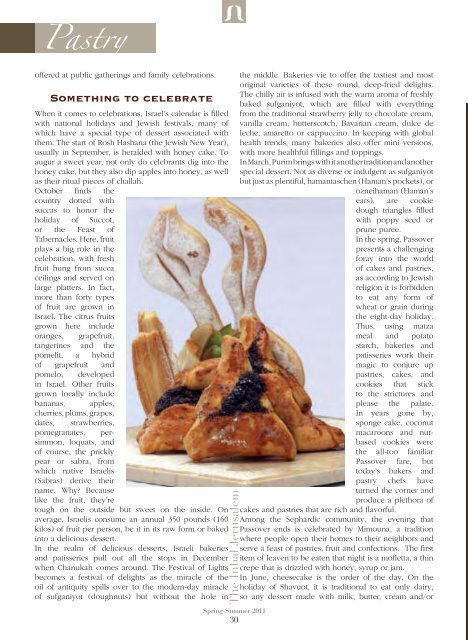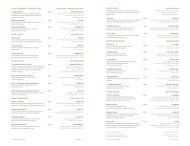Create successful ePaper yourself
Turn your PDF publications into a flip-book with our unique Google optimized e-Paper software.
Pastry<br />
offered at public gatherings and family celebrations.<br />
Something to celebrate<br />
When it comes to celebrations, Israel’s calendar is filled<br />
with national holidays and Jewish festivals, many of<br />
which have a special type of dessert associated with<br />
them. The start of Rosh Hashana (the Jewish New Year),<br />
usually in September, is heralded with honey cake. To<br />
augur a sweet year, not only do celebrants dig into the<br />
honey cake, but they also dip apples into honey, as well<br />
as their ritual pieces of challah.<br />
October finds the<br />
country dotted with<br />
succas to honor the<br />
holiday of Succot,<br />
or the Feast of<br />
Tabernacles. Here, fruit<br />
plays a big role in the<br />
celebration, with fresh<br />
fruit hung from succa<br />
ceilings and served on<br />
large platters. In fact,<br />
more than forty types<br />
of fruit are grown in<br />
Israel. The citrus fruits<br />
grown here include<br />
oranges, grapefruit,<br />
tangerines and the<br />
pomelit, a hybrid<br />
of grapefruit and<br />
pomelo, developed<br />
in Israel. Other fruits<br />
grown locally include<br />
bananas, apples,<br />
cherries, plums, grapes,<br />
dates, strawberries,<br />
pomegranates, persimmon,<br />
loquats, and<br />
of course, the prickly<br />
pear or sabra, from<br />
which native Israelis<br />
(Sabras) derive their<br />
name. Why? Because<br />
like the fruit, they’re<br />
tough on the outside but sweet on the inside. On<br />
average, Israelis consume an annual 350 pounds (160<br />
kilos) of fruit per person, be it in its raw form or baked<br />
into a delicious dessert.<br />
In the realm of delicious desserts, Israeli bakeries<br />
and patisseries pull out all the stops in December<br />
when Chanukah comes around. The Festival of Lights<br />
becomes a festival of delights as the miracle of the<br />
oil of antiquity spills over to the modern-day miracle<br />
of sufganiyot (doughnuts) but without the hole in<br />
The <strong>Inbal</strong> <strong>Jerusalem</strong> <strong>Hotel</strong><br />
Spring-Summer 2011<br />
30<br />
the middle. Bakeries vie to offer the tastiest and most<br />
original varieties of these round, deep-fried delights.<br />
The chilly air is infused with the warm aroma of freshly<br />
baked sufganiyot, which are filled with everything<br />
from the traditional strawberry jelly to chocolate cream,<br />
vanilla cream, butterscotch, Bavarian cream, dulce de<br />
leche, amaretto or cappuccino. In keeping with global<br />
health trends, many bakeries also offer mini versions,<br />
with more healthful fillings and toppings.<br />
In March, Purim brings with it another tradition and another<br />
special dessert. Not as diverse or indulgent as sufganiyot<br />
but just as plentiful, hamantaschen (Haman’s pockets), or<br />
ozneihaman (Haman’s<br />
ears), are cookie<br />
dough triangles filled<br />
with poppy seed or<br />
prune puree.<br />
In the spring, Passover<br />
presents a challenging<br />
foray into the world<br />
of cakes and pastries,<br />
as according to Jewish<br />
religion it is forbidden<br />
to eat any form of<br />
wheat or grain during<br />
the eight-day holiday.<br />
Thus, using matza<br />
meal and potato<br />
starch, bakeries and<br />
patisseries work their<br />
magic to conjure up<br />
pastries, cakes, and<br />
cookies that stick<br />
to the strictures and<br />
please the palate.<br />
In years gone by,<br />
sponge cake, coconut<br />
macaroons and nutbased<br />
cookies were<br />
the all-too familiar<br />
Passover fare, but<br />
today’s bakers and<br />
pastry chefs have<br />
turned the corner and<br />
produce a plethora of<br />
cakes and pastries that are rich and flavorful.<br />
Among the Sephardic community, the evening that<br />
Passover ends is celebrated by Mimouna, a tradition<br />
where people open their homes to their neighbors and<br />
serve a feast of pastries, fruit and confections. The first<br />
item of leaven to be eaten that night is a mofletta, a thin<br />
crepe that is drizzled with honey, syrup or jam.<br />
In June, cheesecake is the order of the day. On the<br />
holiday of Shavuot, it is traditional to eat only dairy,<br />
so any dessert made with milk, butter, cream and/or








